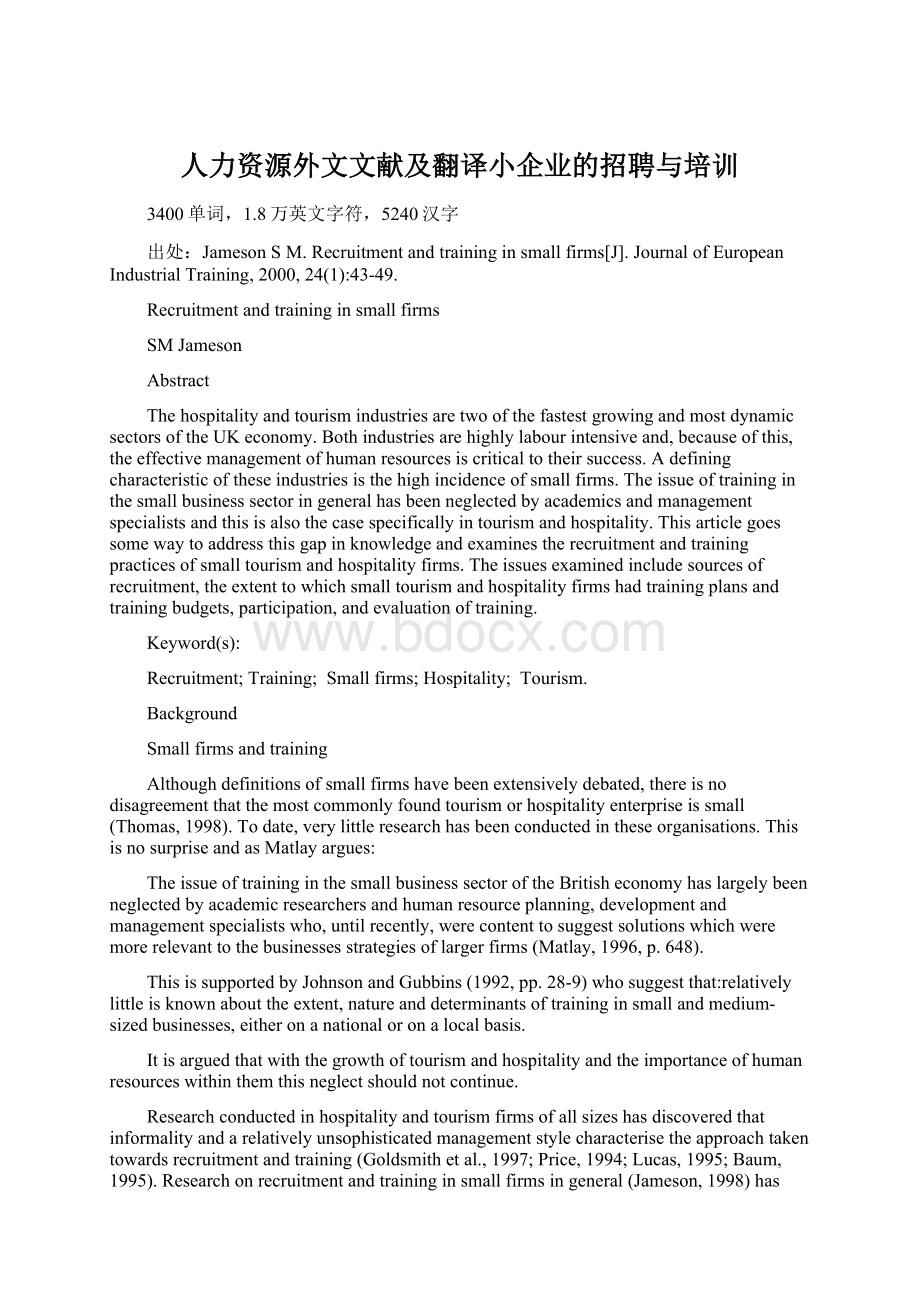人力资源外文文献及翻译小企业的招聘与培训.docx
《人力资源外文文献及翻译小企业的招聘与培训.docx》由会员分享,可在线阅读,更多相关《人力资源外文文献及翻译小企业的招聘与培训.docx(13页珍藏版)》请在冰豆网上搜索。

人力资源外文文献及翻译小企业的招聘与培训
3400单词,1.8万英文字符,5240汉字
出处:
JamesonSM.Recruitmentandtraininginsmallfirms[J].JournalofEuropeanIndustrialTraining,2000,24
(1):
43-49.
Recruitmentandtraininginsmallfirms
SMJameson
Abstract
ThehospitalityandtourismindustriesaretwoofthefastestgrowingandmostdynamicsectorsoftheUKeconomy.Bothindustriesarehighlylabourintensiveand,becauseofthis,theeffectivemanagementofhumanresourcesiscriticaltotheirsuccess.Adefiningcharacteristicoftheseindustriesisthehighincidenceofsmallfirms.Theissueoftraininginthesmallbusinesssectoringeneralhasbeenneglectedbyacademicsandmanagementspecialistsandthisisalsothecasespecificallyintourismandhospitality.Thisarticlegoessomewaytoaddressthisgapinknowledgeandexaminestherecruitmentandtrainingpracticesofsmalltourismandhospitalityfirms.Theissuesexaminedincludesourcesofrecruitment,theextenttowhichsmalltourismandhospitalityfirmshadtrainingplansandtrainingbudgets,participation,andevaluationoftraining.
Keyword(s):
Recruitment;Training;Smallfirms;Hospitality;Tourism.
Background
Smallfirmsandtraining
Althoughdefinitionsofsmallfirmshavebeenextensivelydebated,thereisnodisagreementthatthemostcommonlyfoundtourismorhospitalityenterpriseissmall(Thomas,1998).Todate,verylittleresearchhasbeenconductedintheseorganisations.ThisisnosurpriseandasMatlayargues:
TheissueoftraininginthesmallbusinesssectoroftheBritisheconomyhaslargelybeenneglectedbyacademicresearchersandhumanresourceplanning,developmentandmanagementspecialistswho,untilrecently,werecontenttosuggestsolutionswhichweremorerelevanttothebusinessesstrategiesoflargerfirms(Matlay,1996,p.648).
ThisissupportedbyJohnsonandGubbins(1992,pp.28-9)whosuggestthat:
relativelylittleisknownabouttheextent,natureanddeterminantsoftraininginsmallandmedium-sizedbusinesses,eitheronanationaloronalocalbasis.
Itisarguedthatwiththegrowthoftourismandhospitalityandtheimportanceofhumanresourceswithinthemthisneglectshouldnotcontinue.
Researchconductedinhospitalityandtourismfirmsofallsizeshasdiscoveredthatinformalityandarelativelyunsophisticatedmanagementstylecharacterisetheapproachtakentowardsrecruitmentandtraining(Goldsmithetal.,1997;Price,1994;Lucas,1995;Baum,1995).Researchonrecruitmentandtraininginsmallfirmsingeneral(Jameson,1998)hasalsoindicatedthataninformalapproachtowardsthemanagementofhumanresourcesisthenorminthesefirms.Oneofthemajorthemesinsmallbusinessliteraturehasbeentheexaminationoftheinformalityofrelationsbetweenemployersandemployees.Acorrelationhasbeenfoundtoexistbetweenthesizeoffirmandlevelofformalityinvarioussectorsoftheeconomy(see,forexample,Scottetal.(1989);Curranetal.(1993)).Researchconductedspecificallyinhospitalityfirms(Price,1994,p.49)foundthat:
oneofthemainfindingsfromthesurveywastheimportanceoftherelationshipbetweenestablishmentsizeandemploymentpractices…therewasastrongcorrelationbetweensizeandtheextenttowhichestablishmentshadintroducedpersonnelpolicies,proceduresorotherarrangementswhichmettherequirementsofemploymentlaw.
Thesignificanceofthisrelationshipcannotbeunderestimatedandmustbeborneinmindwheninterpretingtheresultsonrecruitmentandtraininginthesmallfirmsinthesample.
Anymeaningfulanalysisofrecruitmentandtrainingcannotbeundertakenwithoutsomeunderstandingofthelabourmarketwithinwhichsmalltourismandhospitalityfirmsoperate.Muchefforthasbeenexpendeddevelopingtheoreticalmodelsofthelabourmarket.Asfarasthetourismandhospitalityindustriesareconcernedoneofthemostusefultheoriesisduallabourmarkettheory.Goldsmithetal.(1997)summarizethissuccinctly.Duallabourmarkettheoryproposesthatthetotallabourmarketcanbesegmented.Onesectionistheprimarylabourmarket,wherejobstendtobesuppliedbylarge,highlyprofitablefirmswithahighcapitaltolabourratioandhighproductivity.Here,productionisusuallylargescalewithhighinvestmentintechnology.Employmentinthesefirmsisnormallystablewithrelativelyhighskillandwagelevels.Inthiscontext,therearenormallyopportunitiesfortraining.Thesecondarylabourmarketisnormallycharacterisedbysmallfirmswithlowcapitaltolabourratio,lowproductivityandsmallscaleproduction.Inthesefirms,wageandskilllevelstendtobelow,employmentisunstableandtrainingopportunitiesareusuallylimited.Smalltourismandhospitalityfirmsnormallytendtooperatewithinthesecondarylabourmarket.
Thereareobviousrelationshipsbetweenrecruitmentandtraining.Onerelationshipiswheretrainingcanprovidesolutionstoproblemsinthelabourmarket.CampbellandBaldwin(1993)suggestthatinmanyindustrialisedcountriesthereisaconcernthatskillsshortagesandmismatchesareappearinginthelabourmarketandthatpolicymakersareawarethatrecruitmentdifficultiesandskillshortagesmayreducethecompetitivenessofsmallandlargefirms.BradleyandTaylor(1996)suggestthatthereisagrowingawarenessthateducationandtrainingsystemscaninfluencetheskillandoccupationalmixofalocalityandlocaleconomicwellbeing.Anothertypeofrelationshipisonewherethelevelofrecruitmentaffectstheleveloftraining.Intourismandhospitality,withtheirrelianceonthesecondarylabourmarketandhighratesoflabourturnover,thereisastrongtendencytohavehighlevelsofrecruitmentandlowlevelsoftraining.Theargumentsbeingthateitheritisnotworthinvestingintrainingortheresimplyisnottime.
Recruitment
Researchontourismandhospitalityfirmsingeneral(i.e.notspecificallysmallfirms)referstoinformalandunsystematicrecruitmentmethods(LucasandBoella,1996).Others,whohavecarriedoutresearchintorecruitmentinsmallfirmsingeneralhavefoundarelianceoninformalmethods(see,forexample,Curranetal.,1993).Millwardetal.(1992)foundthat,whereaslargerenterprisesreliedgreatlyonformalmethodsandbureaucraticproceduresbyspecialistpersonneldepartments,thesmallbusinessowner/managerislikelytohandlerecruitingandpersonnelmatterswithoutdelegatingandisunlikelytohaveanyrelevantskills.
Training
Tourismandhospitalityhaveoneofthehighestlevelsofskillshortages(HCTC,1995;HEFCE,1998).If,asBradleyandTaylor(1996)suggest,trainingcaninfluencetheskillofalocality,thenitisinterestingtoseehowseriouslysmalltourismandhospitalityfirmstaketraining.
AccordingtoCurranetal.(1996)smallbusinessesexperienceproblemsinprovidingtrainingforbothowner-managersandworkers.IthasalsobeendiscoveredthatthehospitalityindustrydisplaysoneofthelowestlevelsoftrainingactivityintheUKeconomy(HCTC,1995).Thesepointsshouldbeborneinmindwhentheresultsofthissurveyareinterpreted.
Twooftheindicatorsofasystematicapproachtotrainingaretheexistenceofatrainingplan/policyandaspecificbudgetfortraining.
AccordingtotheHospitalityTrainingFoundation(HtF,1996)63percentofemployersinallindustrieshadatrainingplan.Incateringandhospitality64percenthadatrainingplan.Themostrecentresearchontrainingandsmallfirmsfoundthatonly28percentofsuchfirmshadatrainingplan.
Itisappropriatetodiscusstrainingbudgetsalongsidetrainingplans.Itisalsousefultocomparethesurveyfindingswithallindustriesandwiththehospitalityindustry(nofiguresareavailablefortourism).Inallindustries55percentofemployershadtrainingbudgets;inhospitalitythisfigurewas43percentaccordingtoIFFresearch(HtF,1996).However,researchcarriedoutbytheHtFfoundthatonly19percentofhospitalityfirmshadatrainingbudget.
IntheUK,theprovisionoftrainingtoSMEshasbecomeacentralissueofeconomicpolicy(MillerandDavenport,1987).Storey(1994)hasdescribedthisasamajorindirectsmallfirmspolicyinitiative.Overthelastdecade,theprovisionoftrainingandsupporttoSMEshasincreasedconsiderablyinvolvingnationalandlocalGovernment,theprivatesector,andfurtherandhighereducationinstitutes(Westhead,1996.Inthesurveyonsmalltourismandhospitalityfirms,theissueoftrainingprovisionwasexamined.
Thereislittlepointininvestingintrainingwithoutattemptingtomeasureitseffectiveness.Measuringtheeffectivenessoftrainingisextremelydifficultinanysizeoffirm.Thesmallfirmsliteraturesuggeststhatowner-managersofsmallfirmsassessthevalueofworkforcetraininginaninformalwayandtendtousevariouskindsofsubjectiveassessments.Thefirmsinthesurveywerequestionedonifandhowtheymeasuredtheeffectivenessoftraining.
Researchmethod
ResearchersatTheCentrefortheStudyofSmallTourismandHospitalityFirmsbasedatLeedsMetropolitanUniversity,UK,werekeentoexaminebusinesspracticesinsmallfirmsbothbybreadthanddepth.Assuch,itwasdecidedtoadministeraquestionnaireto4,331smallfirms.Intotal,1,103werereturnedcompleted,givingaresponserateof26percent.Theprojectfocusedonfourregions:
Cumbria;HeartofEngland;WestCountry;andYorkshire.Eightsectorswerechosentoprovideabroadlybasedcross-sectionoftheseindustries.Thesesectorswerepublichouse/bar;travelagent;hotel;visitorattraction;B&B/guesthouse;fastfood/takeaway;restaurantorcafé;self-catering.Thevastmajorityoffirmsinthesamplewereindependently-ownedsingleoutletbusinesses